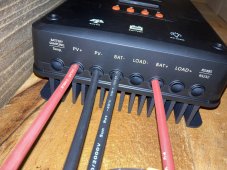Jonathan123
New Member
Ok I made a mistake and almost fried my system. I’m not clear on exactly what the energy flow was or whether I did lasting damage to my equipment.
I had the positive cable that runs between my 12v battery and my solar controller come loose. I was in a rush and when I re-installed it I accidentally put that positive cable into the controller’s negative load port. It sparked green a bit so I didn’t actually attach it. Without noticing my mistake yet I tried again a few very short times and kept getting more sparking than what is normal when connecting, so I stopped and then noticed I had the cable in the wrong port. At that point I had everything disconnected and the wires were very hot. After letting everything cool down I put the positive cable from the battery into the correct port and set it all up as appropriate. I tightened down all connections and the system is working fine again.
My two questions are:
1. What exactly happened when I connected the positive cable from the battery to the negative load port? It was obviously a bad thing but what was happening there that the cable got so hot from just a few brief touches of these connections?
2. The positive cable end was very slightly melted. I could still see individual strands so it wasn’t a total meltdown. Have I done lasting damage to the battery? Since it’s working correctly can I move on or should I replace that positive cable with a new one?
Lesson learned of course. I need to slow down and pay attention in these situations.
I had the positive cable that runs between my 12v battery and my solar controller come loose. I was in a rush and when I re-installed it I accidentally put that positive cable into the controller’s negative load port. It sparked green a bit so I didn’t actually attach it. Without noticing my mistake yet I tried again a few very short times and kept getting more sparking than what is normal when connecting, so I stopped and then noticed I had the cable in the wrong port. At that point I had everything disconnected and the wires were very hot. After letting everything cool down I put the positive cable from the battery into the correct port and set it all up as appropriate. I tightened down all connections and the system is working fine again.
My two questions are:
1. What exactly happened when I connected the positive cable from the battery to the negative load port? It was obviously a bad thing but what was happening there that the cable got so hot from just a few brief touches of these connections?
2. The positive cable end was very slightly melted. I could still see individual strands so it wasn’t a total meltdown. Have I done lasting damage to the battery? Since it’s working correctly can I move on or should I replace that positive cable with a new one?
Lesson learned of course. I need to slow down and pay attention in these situations.



